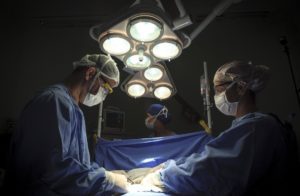 For as long as humans have been performing surgical procedures, there have been concerns and complaints about how such surgeries were performed. The earliest surgeries were most likely performed out of sheer ignorance and desperation, with little knowledge or guidance as to which procedures would produce what results. As early as 6500 B.C., a basic procedure called trepanation, which involved drilling a hole into the patient’s skull, was used to treat abnormal behavior. Then in 1540, the United Barber-Surgeons Company was formed, which brought together barbers and surgeons as they performed blood-letting and tooth extractions.
For as long as humans have been performing surgical procedures, there have been concerns and complaints about how such surgeries were performed. The earliest surgeries were most likely performed out of sheer ignorance and desperation, with little knowledge or guidance as to which procedures would produce what results. As early as 6500 B.C., a basic procedure called trepanation, which involved drilling a hole into the patient’s skull, was used to treat abnormal behavior. Then in 1540, the United Barber-Surgeons Company was formed, which brought together barbers and surgeons as they performed blood-letting and tooth extractions.
But it was not until the 1800’s that surgery, as we recognize it today, began to take place. In the 19th Century, many firsts occurred, including the first blood transfusion, the first public use of anesthesia, the first hysterectomy, and the first appendectomy. (Until about 1885, a diagnosis of appendicitis was generally considered a death sentence as a result of the infection that would spread after the appendix ruptured and sepsis set in. This was because appendectomies were not typically performed at the time.) Other firsts in the late 1800’s included the first X-ray and the first successful heart surgery repair. Cleanliness also became important during surgeries for the first time, in large part due to a medical publication by surgeon Joseph Lister. As chemicals to reduce germs became widely used, infection rates and deaths decreased.
In the 20th Century, surgical firsts continued at a frantic pace, including the following firsts: cornea transplant; plastic surgery; insulin; sex change; metal hip replacement; LASIK eye procedure; successful kidney, liver, heart, hand, and pancreas transplants; laparoscopic surgery; artificial heart implantation; and robotic surgery. Then, in the 21st Century, the first full facial transplant was achieved and the first natural orifice endoscopic surgery was performed. Natural orifice endoscopic surgery allowed procedures to take place through natural body openings, such as the mouth. Today, robotic surgeries such as those performed with the da Vinci robotic surgical system have become commonplace for a wide range of procedures such as coronary artery bypass and prostrate surgeries.
As surgical procedures have evolved over time, patients have ultimately benefited from surgeons pushing the barriers of medical science. But for every medical advance, there have been setbacks along the way and steep learning curves for doctors and surgeons to navigate as they search for better ways to master new surgical techniques. So, over time, some mistakes have been a natural result of exploring new medical technologies.
Sometimes these “mistakes” constitute medical malpractice and sometimes they do not. As medical malpractice involves a surgeon failing to meet the “standard of care” of other similar surgeons in the community, a bad result may or may not be a breach of this standard of care, especially if the surgical procedure is new or experimental. An experienced medical malpractice attorney can examine the medical records involved, often alongside a hired expert, and help reach a conclusion about whether a lawsuit will likely be successful. If you feel you may have a medical malpractice claim, contact the experienced Chicago surgical malpractice lawyers at Sexner Injury Lawyers LLC. Call (312) 243-9922 today for a free case evaluation.


